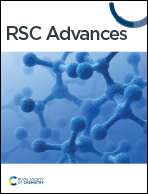Heterogeneous catalytic oxidation of glycerol over a UiO-66-derived ZrO2@C supported Au catalyst at room temperature†
Abstract
The catalytic conversion of biomass-derived glycerol into high-value-added products, such as glyceric acid (GLYA), using catalyst-supported Au nanoparticles (Au NPs) at room temperature presents a significant challenge. In this study, we constructed a series of supported Au catalysts, including Au/ZrO2@C, Au/C, Au/ZrO2, and Au/ZrO2-C, and investigated their effectiveness in selectively catalytic oxidizing glycerol to GLYA at room temperature. Among these catalysts, the Au/ZrO2@C catalyst exhibited the best catalytic performance, achieving a glycerol conversion rate of 73% and a GLYA selectivity of 79% under the optimized reaction conditions (reaction conditions: 30 mL 0.1 M glycerol, glycerol/Au = 750 mol mol−1, T = 25 °C, p(O2) = 10 bar, stirring speed = 600 rpm, time = 6 h). Physical adsorption, X-ray diffraction (XRD), X-ray photoelectron spectroscopy (XPS), transmission electron microscopy (TEM), and other characterization methods were employed to analyze the texture properties of the catalyst. The findings indicated that the support structure, the strong metal–support interactions between Au NPs and the support, and the presence of small metallic Au NPs were the primary factors contributing to the catalyst's high activity and selectivity. Moreover, the reusability of the Au/ZrO2@C catalyst was investigated, and a probable reaction mechanism for the oxidation of glycerol was proposed.



 Please wait while we load your content...
Please wait while we load your content...